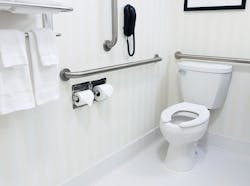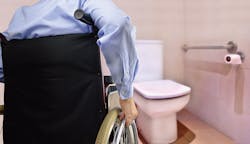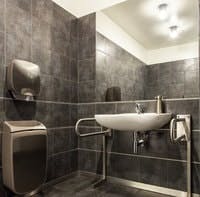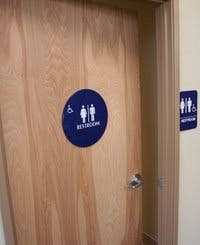Whether you started with a faulty design, your contractors missed the mark, or you just didn’t realize you moved a trashcan into the wheelchair turning radius, it’s crucial that you identify any noncompliant areas now and address them.
How to Handle ADA Complaints - Free Checklist from BUILDINGS
“It’s a common problem because business owners rely on architects and engineers to get this right, and in the end, it’s in the civil rights realm, not building code,” notes David Meihls, Principal Consultant for ADA Consultants of Indiana. “If you don’t consult with an ADA expert and have your business reviewed, there’s a high chance of noncompliance because compliance requires so many intricate moving parts.”
Facilities managers aren’t typically experts in all things ADA, but the facilities team’s handling of ADA compliance – or noncompliance – may make the difference between a verbal complaint vs. a lawsuit. Understand the most common violations of the ADA compliance guidelines and deal with complaints correctly from the start.
Why is important for bathrooms to meet ADA?
“When a person is denied access to use the restroom, you are at a much greater risk of that person not only being denied access, but being thoroughly ticked off,” Meihls explains. “Let’s say he ends up having an accident and has to go home, take a shower, change his clothes, all of that stuff. There’s a pretty good chance he’s going to sue, whereas if someone just had to help him get up a curb ramp, that’s not as big a deal. I think that’s why restrooms are such a hot-button issue.”
If you were fortunate enough to discover an incident of noncompliance on your own, move quickly to get the issue fixed before you receive a complaint – or worse, a lawsuit. On the other hand, if you’re made aware of the problem because a person with a disability has run into complications gaining access, Meihls suggests starting with compassion and sincerity, then rectifying the problem as quickly as possible.
“Acknowledge that the person has an issue and let them know you’re aware. If you weren’t aware before, tell them you’ll look into what you can do and ask if there’s anything you can do right now to assist them,” Meihls recommends. “Thank you for bringing this to our attention. We’ll investigate it further and try to get it fixed. In the meantime, what can I do to help you have a better experience right now?”
When you investigate, it’s also important to document everything, from the ADA compliance requirement you’re accused of violating to the real-life conditions of the noncompliant space. Take photos of the area referenced in the complaint and have the areas measured, preferably by an architect or another building professional who’s an ADA compliance expert, recommends Dan Chancey, BOMA Fellow and Senior Vice President, Asset Management, for Cushman & Wakefield/Commercial Advisors.
Whatever you do, don’t ignore it and hope it will go away, and don’t try to save money by dealing with it on your own. Consultants are paid to be experts on this topic, so don’t be afraid to use their expertise.
“People are afraid to hire experts and say, ‘We don’t need them, we can figure this out ourselves.’ Well, maybe you can, but you’re really taking a risk and with ADA, it’s not worth the risk,” Chancey explains. “Engage a good architect who can help you navigate those waters. Most property management folks know a little bit about a lot of things, but an architect knows a lot about certain focus areas, and that’s what you need here.”
5 Common ADA Restroom Compliance Mistakes
Certain ADA compliance issues seem to crop up more frequently than others, but it’s important to note that the following is not an exhaustive list. To see all of the ADA compliance requirements, see the 2010 ADA Standards for Accessible Design at www.ada.gov.
Sinks are frequently too tall as well, especially base cabinet models, Meihls adds: “Sinks are often installed higher than 34 inches. Standard base cabinets are 36 inches high – you have to special order to get one that’s 34 inches high, so that’s a common problem.”
ADA Compliance Misconceptions
These common pitfalls can spell trouble for ADA compliance, not just in restrooms, but in the rest of your facility. If any of these sound familiar, you may be at risk of additional complaints, lawsuits or fines.
"No people with disabilities use this space."
Making assumptions can be your downfall even if your restroom is literally on top of a mountain, Meihls explains.
“There was a lawsuit in the late ‘90s involving a group of about 10 people on the Appalachian Trail,” Meihls says. “This is a federally funded trail and one of the people in the group was in a wheelchair. They were about 10,000 feet up and everyone had to use the bathroom, and the only bathroom was this toilet mounted on a base that was just sitting out in the open. Everyone could use it except for the guy in the wheelchair, who then sued the federal government over it. They came back and said, ‘Even if we’re installing toilets at 10,000 feet, we can’t assume that a person in a wheelchair isn’t going to make this climb’ because he did. If you service the public, no matter what your business is, you have to include people with disabilities.”
Spaces that are normally closed to non-members, like churches, can also run into trouble here, Meihls adds. Places of worship are only exempt from ADA if they don’t allow non-members to use the space. However, many have gathering spaces that can be rented out for weddings, graduations and other events, which means they must abide by ADA. Meihls suggests consulting the Department of Justice’s A Primer for Small Business at www.ada.gov to understand some of the basics of accessibility, ADA compliance, and when a building does and doesn’t have to comply.
"My local code official said my building is close enough."
ADA compliance is a civil rights law, not a regular building code, and it offers zero variance. “On a normal code, if the distance between two doors is a half-inch off, the code inspector may decide to say ‘I know you’re putting these doors as far as you can from each other, so for this particular application, you’re satisfying the code in my book’ and sign off on it,” explains Chancey. “They’ll even sign off on ADA, but that doesn’t get you off the hook. If you miss an ADA requirement by a half inch or three-quarters of an inch, you’ll lose with the Justice Department.”
"If someone complains about ADA compliance later, I can just fix it then."
The law has no cure period, Chancey explains. That means that if you receive a complaint, you’re vulnerable to a lawsuit right away because there’s no grace period giving you a certain amount of time to rectify the problem. “If it’s wrong on day one, someone can sue you on day two,” Chancey says. “BOMA is advocating for a cure period so you have an opportunity to deal with the discrepancy before you get sued.”
“The most important thing that a building manager, owner or landlord can do is engage with an architect that knows the ADA compliance well,” Chancey adds. “I need to know that I’ve hired someone who’s not just going to design or draw floor plans, but an architect that really understands the ins and outs of ADA in addition to other codes. That’s where a lot of people make mistakes.”
How do I pay for ADA compliance bathroom upgrades?
There are two tax incentives that can help defray the cost of making businesses accessible to people with disabilities.
Disabled Access Credit
What it is: 50% of expenditures between $250 and $10,250, with a maximum benefit of $5,000. The credit amount is subtracted from your company’s total tax liability. This credit is available every year.
Who can claim it: Businesses with up to $1 million in revenue or 30 or fewer full-time employees.
Use it for: Printing materials in accessible formats, removal of barriers, purchasing adaptive equipment or modifying existing equipment, interpreters and readers, consulting fees and more.
Barrier Removal Tax Deduction
What it is: Annual deduction of up to $15,000 for expenses incurred to remove physical, structural and transportation barriers for people with disabilities in the workplace. The amount spent is subtracted from your business’s income, lowering the amount of income you’ll be taxed on.
Who can claim it: Any business.
Use it for: Removing existing architectural barriers by providing accessible alternatives, such as parking spaces, ramps, curb cuts, phones, water fountains, restrooms and walkways. Not applicable to new construction, complete renovations or normal replacement of depreciated property.
Source: DEPARTMENT OF LABOR
About the Author
Janelle Penny
Editor-in-Chief at BUILDINGS
Janelle Penny has been with BUILDINGS since 2010. She is a two-time FOLIO: Eddie award winner who aims to deliver practical, actionable content for building owners and facilities professionals.





